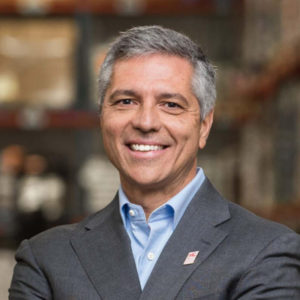After decades of relying on donated food, food banks are starting to place more emphasis on purchasing food.
The trend appears to be an outgrowth of Covid, which forced food banks to purchase food by the truckload as constricted supply chains put the squeeze on donated food. The purchases, along with innovations like the Farmers to Families produce boxes, introduced a steady stream of healthy food into the charitable food system — which is now proving a hard habit to break.
Second Harvest Food Bank of Orange County is like many of its peers in altering its budget to prioritize purchased food. Claudia Keller, Chief Mission Officer, described the food bank as “typical” in purchasing only 10% to 20% of its food pre-pandemic, and relying on donations for the rest. Going forward that model is flipping, with the food bank planning to purchase about 60% of the food it distributes.

“Our intention is to distribute only healthy food,” Keller said. “We’re turning away loads of food that don’t meet our nutritional standards.”
The food bank’s latest budget allocates $4.2 million toward purchased food in the coming year, compared to less than $1 million annually before the pandemic. With purchased food, the food bank hopes to consistently provide the backbone of a healthy diet to families shopping in pantries. “Getting eggs will no longer be a cause for celebration,” Keller said. “They will be there every time.”
Maryland Food Bank is also making budgeting adjustments with an eye toward sourcing greater volumes of healthy food. It increased its food-purchasing budget by 483% during the pandemic to $33 million, compared to only $6 million for the same 14-month period before the pandemic. Going forward, it is planning to purchase more than 50% of its food, compared to 25% to 30% pre-pandemic, said Carmen Del Guercio, President and CEO.
“Purchasing gives us extreme flexibility in terms of being truly intentional about the type of food we want to buy,” Del Guercio said. Though it’s a more expensive operating model, purchasing “provides much better health outcomes,” he added.
The story is similar at the Peoria, Ill., division of Midwest Food Bank, which increased food purchasing by 724% during the pandemic, according to Executive Director Monica Scheuer, RN, MS, RD, LD. Going forward, Scheuer is altering the budget to accommodate an elevated level of purchasing, specifically for high-quality food.

“If we have to purchase food, it’s not going to be hotdogs,” noted Scheuer, who came to the food bank seven years ago as a dietician and nurse, and has been endeavoring to improve nutritional quality ever since. “We could feed a lot of people with hotdogs, but it will be fruits and vegetables.”
At Greater Boston Food Bank, purchased food has been an important part of food sourcing since the early nineties, and will continue to be so, said Catherine D’Amato, President and CEO. During the pandemic, the food bank’s overall budget nearly doubled from $48 million to $92 million, and next year will likely reach $100 million. “A lot of that is for purchasing food,” D’Amato said. “It’s the best way to have the nutritional impact guaranteed.”
Ballooning food-bank budgets raise the question of how food banks can sustain their investments in purchased food. Some expect that donors who became newly attuned to the issue of food insecurity during the pandemic will continue to support the goal of nutritious food. “We’ve gotten a lot of new donors that we will work to continue to keep happy,” noted Sasha Purpura, Executive Director at Cambridge, Mass.-based Food for Free, which primarily operates as a food rescuer.
Food for Free has dramatically increased its food purchasing budget from about $200,000 before the pandemic to a planned $1.4 million for the next fiscal year. In addition to a higher level of fundraising, Food for Free expects to support its expanded purchasing via efficiencies gained through a newly opened warehouse and other operational changes.

Another pathway to sustainability lies in convincing funders of the value of distributing nutritious food, even if the total amount of food distributed is lower. While food banks have been focused on outputs such as pounds as a major driver of success, there is increasing attention being paid to health outcomes. “Shifting away from pounds to the quality of food consumed will drive more funding,” predicted Maryland Food Bank’s Del Guercio.
Second Harvest of Orange County has already begun turning that directive into action. With a goal of distributing 100% nutritious food, it plans to measure its output only in terms of healthy food. In addition, it will measure its success by its ability to bring that number down. “When you get to brass tacks, we really should be shrinking our presence, not growing it,” said Keller.
The goal of diminishing its presence has been welcomed both by funders and the food bank’s pantry network, said Keller, who noted that the past 35 years has been characterized by relentless growth in the food bank’s output and number of people served. “But we were maintaining,” she said. “If we’re going to achieve our mission, we have to think differently.” — Chris Costanzo
Like what you’re reading?
Support Food Bank News












